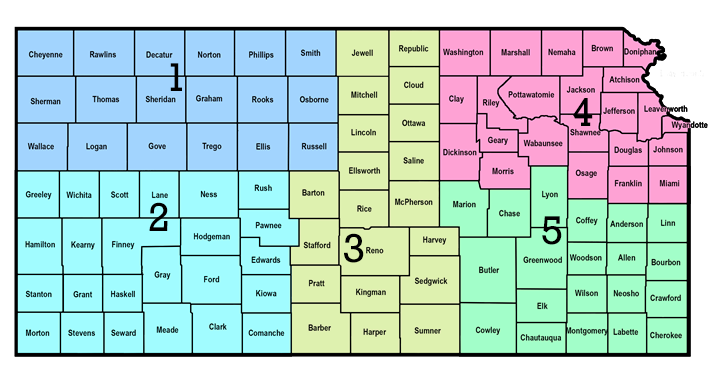(This website was updated 2/22/2024)
Welcome to the Division of Conservation (DOC)
Conservation of natural resources is an important concern for all Kansans. The Division of Conservation (DOC), working with 105 local Conservation Districts, 75 organized Watershed Districts, other special-purpose districts, as well as state and federal entities administer programs to improve water quality, reduce soil erosion, conserve water, reduce flood potential and provide local water supply. The DOC has the responsibility to administer the Conservation Districts Law, the Watershed District Act and other statutes authorizing various programs. The agency budget is financed from the dedicated funding of the Kansas State Water Plan Special Revenue Fund, State General Fund, and fee funds.
 These five conservation regions are each represented by a commissioner who serves on the State Conservation Commission.
These five conservation regions are each represented by a commissioner who serves on the State Conservation Commission.
Kansas Association of Conservation Districts (KACD)
Kansas Association of Conservation District Employees Organization (KACD-EO)
National Association of Conservation Districts (NACD)
National Association of State Conservation Agencies (NASCA)
State Conservation Commission (SCC)
USDA Natural Resources Conservation Service (NRCS)
Kansas Water Office (KWO)
Kansas Forest Service (KFS)
Kansas Department of Health and Environment (KDHE)
Watershed Restoration & Protection Strategy (WRAPS)
Kansas Department of Wildlife and Parks (KDWP)
State Association of Kansas Watersheds (SAKW)
Kansas State University (KSU)
USDA Farm Service Agency (FSA)
Watershed Districts
KDA Makes Soil Erosion Resources Available to Kansas Landowners
by
User Not Found | Feb 18, 2013
The Kansas Department of Agriculture has created a special webpage with resources and additional information the department's Division of Conservation, K-State Research and Extension and the U.S. Department of Agriculture's Natural Resources Conservation Service to further assist landowners preserve top soil from wind erosion. For more information, http://agriculture.ks.gov/divisions-programs/division-of-conservation/soil-erosion-caused-by-wind
As Kansas enters the third consecutive year of drought, the threat of soil erosion caused by wind is increased. Farmers and ranchers have improved practices over the years to help conserve top soil. The Kansas Department of Agriculture has created a special
webpage with resources and additional information the department's Division of Conservation, K-State Research and Extension and the U.S. Department of Agriculture's Natural Resources Conservation Service to further assist landowners preserve top soil from wind erosion.